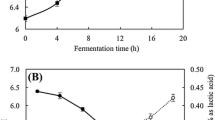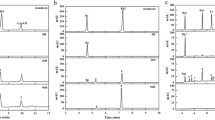Abstract
Korean ginseng was fermented using Aspergillus niger (A. niger) FMB S494 and mycotoxins such as ochratoxin and fumonisin were not detected in the fermented ginseng. Protopanaxadiol-type ginsenosides such as glycosylated forms of Rb1, Rb2, Rc, and Rd decreased to 0 while compound K (cK) increased from 0 to 9 × 104 ppm in the extract of fermented ginseng. Protopanaxtriol-type ginsenosides such as Re and Rg1 decreased from 7.1 × 104 to 3.0 × 104 ppm and 6.8 × 104 to 4.6 × 104 ppm, respectively. Rg2 and Rh1 increased from 0 to 1.9 × 104 ppm and 0 to 2.7 × 104 ppm, respectively. We can demonstrate that A. niger was more inclined to transform protopanaxadiol-type ginsenosides. Moreover, fermented ginseng extract showed a dramatically enhanced anti-proliferative effect on human HT-29 cell line with a minimum effective concentration of about 1 µg/mL, which might be attributed to the high degree of biotransformation of ginsenosides, especially the high output of ginsenoside cK.



Similar content being viewed by others
References
Banthorpe DV. Terpenoids. in Natural Products, ed. by J. Mann (Longman Scientific and Technical, Essex, 1994), pp. 331–339
Tawab MA, Bahr U, Karas M, Wurglics M, and Schubert-Zsilavecz M. Degradation of ginsenosides in humans after oral administration. Drug Metab. Dispos. 31: 1065–1071 (2003)
Yim J-S, Kim Y-S, Moon S-K, Cho K-H, Bae H-S, Kim J-J, Park E-K, and Kim D-H. Metabolic activities of ginsenoside Rb1, baicalin, glycyrrhizin and geniposide to their bioactive compounds by human intestinal microflora. Biol. Pharm. Bull. 27: 1580–1583 (2004)
Wang C-Z, Zhang B, Song W-X, Wang A, Ni M, Luo X, Aung HH, Xie J-T, Tong R, and He T-C. Steamed American ginseng berry: ginsenoside analyses and anticancer activities. J. Agric. Food Chem. 54: 9936–9942 (2006)
Han B, Park M, Han Y, Woo L, Sankawa U, Yahara S, and Tanaka O. Degradation of ginseng saponins under mild acidic conditions. Planta Med. 44: 146–149 (1982)
Chen Y, Nose M, and Ogihara Y. Alkaline cleavage of ginsenosides. Chem. Pharm. Bull. 35: 1653–1655 (1987)
Ko S-R, Choi K-J, Uchida K, and Suzuki Y. Enzymatic preparation of ginsenosides Rg2, Rh1, and F1 from protopanaxatriol-type ginseng saponin mixture. Planta Med. 69: 285–286 (2003)
Bae E-A, Shin J-E, and Kim D-H. Metabolism of ginsenoside Re by human intestinal microflora and its estrogenic effect. Biol. Pharm. Bull. 28: 1903–1908 (2005)
Wan J-Y, Liu P, Wang H-Y, Qi L-W, Wang C-Z, Li P, and Yuan C-S. Biotransformation and metabolic profile of American ginseng saponins with human intestinal microflora by liquid chromatography quadrupole time-of-flight mass spectrometry. J. Chromatogr. A. 1286: 83–92 (2013)
Park C-S, Yoo M-H, Noh K-H, and Oh D-K. Biotransformation of ginsenosides by hydrolyzing the sugar moieties of ginsenosides using microbial glycosidases. Appl. Microbiol. Biotechnol. 87: 9–19 (2010)
Han Y, Sun B, Hu X, Zhang H, Jiang B, Spranger MI, and Zhao Y. Transformation of bioactive compounds by Fusarium sacchari fungus isolated from the soil-cultivated ginseng. J. Agric. Food Chem. 55: 9373–9379 (2007)
Chen G-T, Yang M, Song Y, Lu ZQ, Zhang JQ, Huang HL, Wu L-J, and Guo D-A. Microbial transformation of ginsenoside Rb1 by Acremonium strictum. Appl. Microbiol. Biotechnol. 77: 1345–1350 (2008)
Kim NY, Lee I, and Ji GE. Reliable and simple detection of ochratoxin and fumonisin production in black Aspergillus. J. Food Protect. 77: 653–658 (2014)
Kim NY, Lee JH, Lee I, and Ji GE. An evaluation of aflatoxin and cyclopiazonic acid production in Aspergillus oryzae. J. Food Protect. 77: 1010–1016 (2014)
Li Z, Ahn HJ, Kim NY, Lee YN, and Ji GE. Korean ginseng berry fermented by mycotoxin non-producing Aspergillus niger and Aspergillus oryzae: ginsenoside analyses and anti-proliferative activities. Biol. Pharm. Bull. 39: 1461–1467 (2016)
Sanchez JF, Somoza AD, Keller NP, and Wang CC. Advances in Aspergillus secondary metabolite research in the post-genomic era. Nat. Prod. Rep. 29: 351–371 (2012)
Ko SK, Bae HM, Cho OS, Im BO, Chung SH, and Lee BY. Analysis of ginsenoside composition of ginseng berry and seed. Food Sci. Biotechnol. 17: 1379–1382 (2008)
Joh EH, Lee IA, Jung IH, and Kim DH. Ginsenoside Rb1 and its metabolite compound K inhibit IRAK-1 activation—the key step of inflammation. Biochem. Pharmacol. 82: 278–286 (2011)
Park D, and Yoon M. Compound K, a novel ginsenoside metabolite, inhibits adipocyte differentiation in 3T3-L1 cells: involvement of angiogenesis and MMPs. Biochem. Biophys. Res. Commun. 422: 263–267 (2012)
Li W, Zhang M, Gu J, Meng ZJ, Zhao LC, Zheng YN, Chen L, and Yang GL. Hypoglycemic effect of protopanaxadiol-type ginsenosides and compound K on Type 2 diabetes mice induced by high-fat diet combining with streptozotocin via suppression of hepatic gluconeogenesis. Fitoterapia. 83: 192–198 (2012)
Wang CZ, Du GJ, Zhang Z, Wen XD, Calway T, Zhen Z, Musch MW, Bissonnette M, Chang EB, and Yuan C-S. Ginsenoside compound K, not Rb1, possesses potential chemopreventive activities in human colorectal cancer. Int. J. Oncol. 40: 1970–1976 (2012)
Quan K, Liu Q, Wan JY, Zhao YJ, Guo RZ, Alolga RN, Li P, and Qi LW. Rapid preparation of rare ginsenosides by acid transformation and their structure-activity relationships against cancer cells. Sci. Rep. 5: 8598 (2015)
Choi CH, Kang G, and Min YD. Reversal of P-glycoprotein-mediated multidrug resistance by protopanaxatriol ginsenosides from Korean red ginseng. Planta Med. 69: 235–240 (2003)
Jin J, Shahi S, Kang HK, van Veen HW, and Fan T-P. Metabolites of ginsenosides as novel BCRP inhibitors. Biochem. Biophys. Res. Commun. 345: 1308–1314 (2006)
Acknowledgements
This work was supported by Cooperative Research Program for Agriculture Science and Technology Development, Rural Development Administration, Republic of Korea (Project No. PJ01123001); and the Promoting Regional specialized Industry, the Ministry of Trade, Industry and Energy (MOTIE) and Korea Institute for Advancement of Technology (KIAT), Republic of Korea (Project No. R0004140).
Author information
Authors and Affiliations
Corresponding author
Ethics declarations
Conflict of interest
The authors declare no conflict of interest.
Rights and permissions
About this article
Cite this article
Li, Z., Ji, G.E. Ginseng fermented by mycotoxin non-producing Aspergillus niger: ginsenoside analysis and anti-proliferative effects. Food Sci Biotechnol 26, 987–991 (2017). https://doi.org/10.1007/s10068-017-0117-z
Received:
Revised:
Accepted:
Published:
Issue Date:
DOI: https://doi.org/10.1007/s10068-017-0117-z




